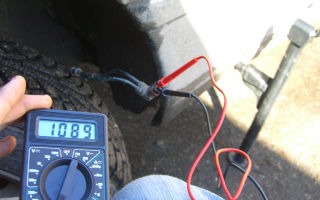How to check the abs sensor with a tester
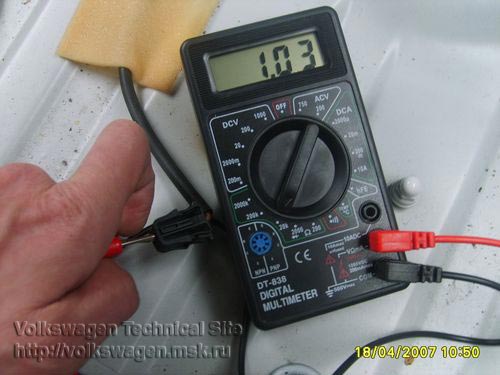

How to test the ABS sensor with a tester? This question is asked by many car enthusiasts who have encountered problems with the brake system.
Indeed, this option is extremely important for a modern car, because it allows you to evenly distribute pressure in the brake system, while maintaining the same course of movement even during sudden braking. It is difficult to overestimate the importance of this system on slippery surfaces - in snow, rain or ice.
The slightest malfunction of the brakes can lead to an accident or driving into a ditch. Therefore, let's look in detail at how to check the ABS sensor with a tester and, if possible, fix the problem as quickly as possible.
To begin with, it is worth noting that if your warning light comes on, indicating a malfunction of the brake system, you should contact a specialist.
Thus, you will receive guarantees that the problem will be completely eliminated and you will be able to diagnose the entire system.
But in some situations, especially when the driver already has certain skills in self-repair, you can watch the video on how to test the ABS sensor with a tester.
Having studied the algorithm of operation of the braking system in more detail, you can see that the anti-lock braking system sensors are bolt-mounted to the brake calipers. On one side, a wire from the central control unit is connected here, and on the other, a magnetic cap that mates with the ABS gear. It is this valve that allows you to create the necessary pressure in the brake system.
One of the common problems with the ABS system is broken wiring. In this case, you should not look for a video on how to check the ABS sensor with a tester, because you can simply ring each wire leading to the caliper from the central unit. If you don’t have a tester at hand, at least look at the integrity of the insulation, the absence of oxidation, or the quality of the contact.
But how can you check the ABS sensor if everything is fine with the wiring? With such symptoms, as experience shows, the problem is hidden in the sensor itself, which will have to be replaced.
To do this, raise the car on a lift or with a jack, remove the wheel, unscrew the bolt holding the sensor, remove the two terminal blocks and replace the old sensor with a new one.
Be sure to check the new element using a tester, making sure that its circuit is intact. If you hear a clear crackling sound while driving when pressing the brake pedal, then the system is working properly.
It is worth remembering that sometimes the ABS fault warning light may fire falsely. This situation occurs when there are large differences in tire pressure or disproportionate tread wear.
The system recognizes this condition as a malfunction and provides corresponding information to the warning lamp.
Fixing the problem is not difficult - just inflate the tires to the recommended pressure or install a tire with intact tread.
As you can see, if you have the appropriate skills, checking the ABS sensor is a fairly simple procedure. But if you still do not have experience working with the brake system, it is better to go to professionals for help.
Source: http://www.sysmet.ru/poleznaya-informaciya/kak-proverit-datchik-abs-testerom
Checking the ABS sensor yourself: possible methods
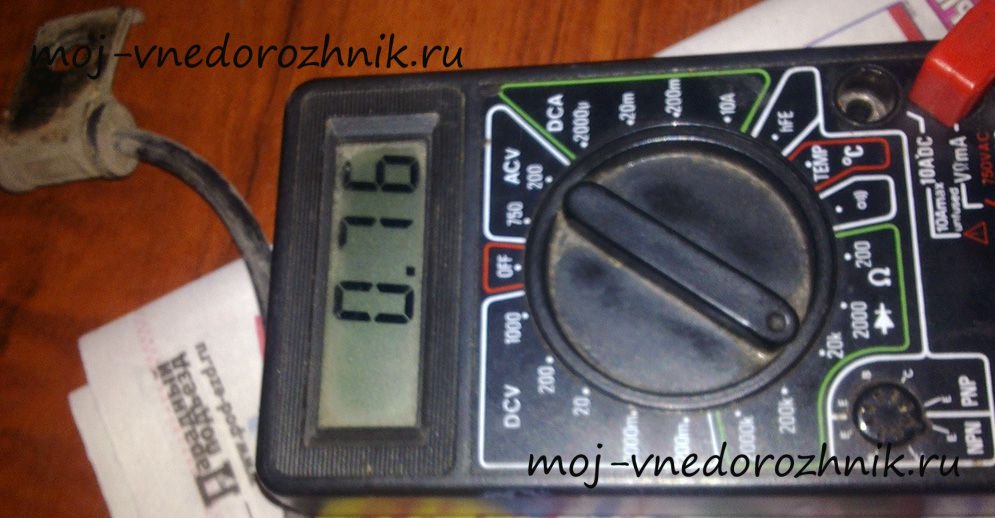
ABS (Anti-lock Braking System) is a system that helps the car brake smoothly, without skidding, and at the same time most effectively. The device operates on electronics, which is based on a control unit for many different sensors.
The ECU monitors the braking progress, preventing wheel locking, which often causes the car to skid during sudden braking, especially in bad weather conditions (for example, ice).
Without false modesty, we can safely say that thanks to the presence of an anti-lock wheel system on cars, hundreds, and maybe thousands of serious fatal accidents can be avoided every day.
Possible system malfunctions and ways to eliminate them
Most often, the ABS system stops functioning normally when the main sensor that sends signals to the dashboard fails. If this element malfunctions, an emergency indicator in the form of three Latin letters lights up on the dashboard - ABS.
It is quite possible to check the condition of the sensor at home if you have a multimeter. The most common breakdown in the ABS system is a break in the electrical circuit that provides communication between the sensor and the control unit. We will talk about the reasons for the gap a little later, but for now we will figure out how to understand that the sensor or system is faulty.
Main symptoms of a malfunction
The first and most important sign is a blinking or persistent, non-extinguishing signal of the indicator, which we already mentioned at the beginning of the article. This usually happens when you turn the key in the ignition, braking, or while the car is moving.
When the engine starts, the sensor lights up even when the system is working properly. Thus, the indicator signals that the system is conducting automatic self-diagnosis.
If everything is in order, the light goes out as soon as the engine starts and starts idling.
During a braking maneuver, a malfunction can be detected by the absence of a characteristic sound emitted by the ECU. When you press the brake pedal sharply in case of emergency braking, vibration should be felt. If this does not happen, and the wheels slip during braking, the system has failed.
What should you do first?
Check the ABS sensors located at the wheel hubs: the system may fail due to a broken wire, or damage to the housing of one or more sensors.
Any of the system malfunctions, one way or another, must be accompanied by a corresponding indication on the dashboard.
If physical manifestations are present, but the indicator is “silent,” it means that the break is located in the section of the circuit leading from the computer to the indicator, or a program failure has occurred in the control unit itself.
Checking the ABS sensor
If we manage to discover which sensor is faulty, we check it immediately. In cases where the cause is unknown, you will have to diagnose all elements in turn. So:
- We jack up the car and remove the wheel to get to the sensor.
- We dismantle the housing, the protective control unit and the connectors that provide power to the sensors.
- We connect additional wires to the wire with PIN connectors and connect them to the sensor and multimeter.
- We measure the resistance, the values of which must correspond to those required by default (you can find out this either in the manual or from an employee of the car dealership where the car was purchased).
- We “ring” the wiring to determine if there is a break or short circuit somewhere.
We rotate the wheel manually and at the same time observe the multimeter readings - the resistance values should change like this:
- leg device – from 5 to 26 ohms.
- device-“mass” – starting from 20 com and above.
Checking the ABS sensor with a tester - measuring the voltage
We hang the wheel, turn on the multimeter and set it to measure DC voltage. Then we connect its electrodes to the connectors and, rotating the wheel at an approximate speed of 1 revolution per second, observe the values of the device. If the ABS sensor is working properly, the readings will be ≈ 0.25-1.2 V. As the wheel speed increases, the data on the device will also be higher.
Checking the sensor using an oscilloscope
If you do not have a multimeter, the condition of the ABS sensor can be checked using a professional tester. During the test, the device will produce a graph. By analyzing the amplitude, you can draw conclusions regarding the health of the sensor.
The only disadvantage of such a check is that such devices are not found at every service station, and even more so in garages, where motorists usually repair their iron horses themselves. Plus, to work with such a device you need to have certain knowledge.
But there is good news: in all modern cars, the ABS system is equipped with a self-diagnosis function. To determine the malfunction, you will only need to find out the error code using the software and decipher it using a special table.
ABS sensor repair
Many motorists are interested in the question: is it possible to repair a failed sensor? It all depends on what exactly is broken. It’s easier, of course, to buy a new one, since repairs can be quite complicated.
Well, if the whole problem is simple damage to the wiring, it’s very easy to fix everything here. As for damage to the winding or core, it is better to replace the sensor.
However, among craftsmen there are people who repair even complex breakdowns. Therefore, everyone makes their own decision regarding repair or replacement.
We hope that the article was useful to you, and we wish you good luck on the roads!
Source: http://autoremka.ru/vaz/proveryaem-datchik-abs-samostoyatelno-vozmozhnyie-sposobyi.html
How to check the abs sensor
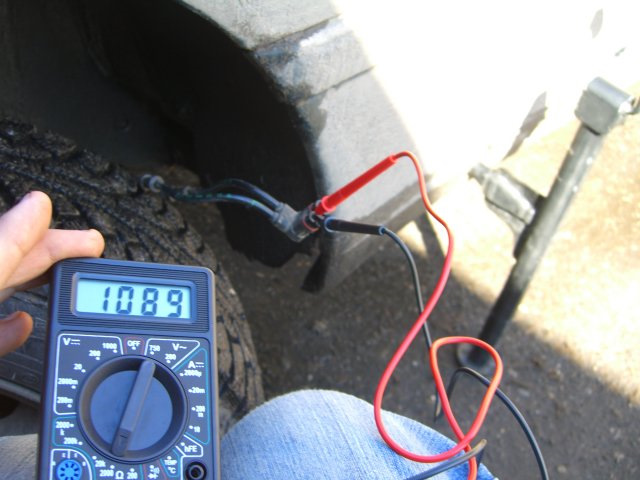
How to check the abs sensor? In order to identify faults in the ABS sensor, you first need to pay attention to whether the ABS light is on. There will also be a malfunction if the ABS system is activated when you press the brake pedal at the end of braking. This means you need to fix one of the four ABS sensors. Each of them is located on a car wheel.
https://www.youtube.com/watch?v=8wGuwnuPS9Q
In order to check the abs sensor you need a tester. The tester switch should be in the 20k position. Now we need to identify which sensor is faulty.
To do this, you need to check by connecting the tester to each of the two rear sensor connectors located under the rear seat.
If the sensor is working properly, then the tester readings should remain at the specified value. Next, check the front wheel sensors.
To do this you will need to remove one of the wheels. The connector is located on the sensor. It needs to be disconnected and connected to the two contacts of the sensor. If the tester reading changes very much from the specified value, then the sensor should be replaced, because it is faulty. After checking the abs sensors is completed and faulty ones are identified, they need to be replaced.
How to replace a faulty sensor?
Unscrew the bolt that secures the sensor. Then, using a screwdriver, the sensor is removed from the mounting hole. If you can’t get it out carefully, you can simply break it and take it out in pieces. It is important not to damage the abs. Next, a new sensor is installed. The sensor body must be rocked from side to side to avoid distortion or breakage of the sensor itself.
It may be that the abs system will throw an error, but this may not be particularly concerning. However, the consequences may not be the best. The braking system will especially fail in icy conditions or bad weather. You can diagnose the ABS system and check what exactly is faulty. There are special diagrams that can be used to determine the serviceability of abs sensors.
Found a mistake? Select the text with the mouse and press Ctrl+Enter What is needed to check the ABS sensor In addition to ABS, a modern car Checking the crankshaft position sensor in test mode: In this article we will provide information on how to check The idle speed sensor is a device of the engine management system that serves the Main functions of the speed sensor Daewoo speed sensor nexifuel sensor VAZThe fuel level sensor VAZ is designed to determine the fuel level in a car and consists of: Malfunction of the fuel level sensor If the fuel level sensor does not work Self-repair of the handbrake It is not uncommon to encounter a problem when the handbrake does not hold.Show more
Source: http://vsepoedem.com/story/kak-proverit-datchik-abs
How to check the ABS sensor with a multimeter
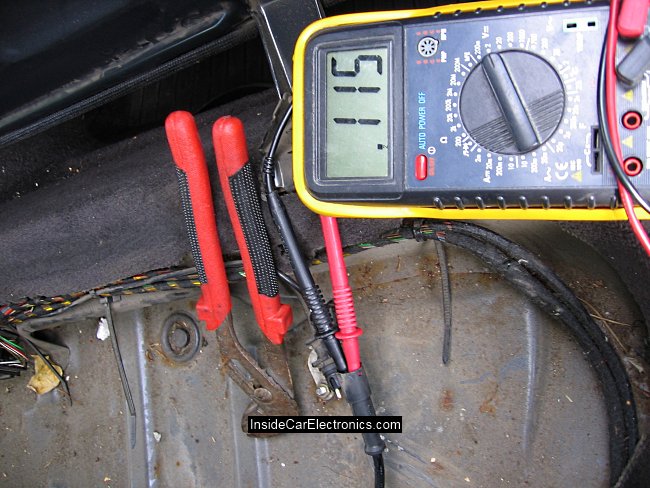
systems and serviceable brakes are the basis for reliable driving, especially in difficult road conditions. If, while driving a vehicle, the ABS malfunction indicator lights up on the dashboard, you should immediately take measures to eliminate it.
In addition, if one of the ABS sensors does not work correctly, this leads to a complete failure of the anti-lock, traction control, and directional stability systems, if they are installed on the car.
Diagnostics of ABS complex
Before you start checking the ABS sensor, you should find out which one is not transmitting a signal. The easiest way to do this is through computer diagnostics.
For cars produced after the 2000s, this is not difficult. OBD scanners clearly determine which one does not provide information about the state of the rotational movement of the wheel.
But this information does not always indicate a malfunction of the sensor itself. On the contrary, in most cases, the ABS sensor itself is fine, and the fault lies in the wiring going to it or the wheel rotation reader.
Operating principle of the ABS sensor
The ABS sensor is electromagnetic. In other words, a magnetic core and inductance are built into it, which react to the signal received when the wheels rotate.
Experienced motorists know that when braking on a slippery road, press the brake pedal intermittently in order to prevent the wheels from locking, which can lead to uncontrollability of the car.
In principle, the ABS unit does this function. It does not allow the wheels to lock. If the diagnostics indicate a malfunction of the ABS sensor, first check its functionality.
Specifically, computer diagnostics can demonstrate “open or short circuit” or “no signal” faults. In both cases, the ABS sensor may be to blame.
How to use a tester to check the ABS sensor for functionality
Its performance can be checked using a multimeter. To do this, you need to move the multimeter to the “diode” position. Because of which? Most of the ABS sensors in the circuit have protection in the form of a diode connected in series to the circuit circuit.
In other words, a simple call can lead to incorrect information.
It needs to be “ringed” in both directions. In most cases, the resistance of the ABS sensor ranges from several hundred Ohms to 2 kiloOhms.
But, checking the sensor specifically from its connector does not provide all the data about the passage of its signal to the ABS unit.
In many cases, the cable connecting the sensor connector to the ABS unit is damaged. Such malfunctions are especially common for rear wheel ABS sensors, since the cable length can be more than 3 meters, and manufacturers do not always design its routing correctly.
During the repair of ABS systems, there are cases of up to three fractures or rubbing of the anti-lock brake system sensor cables.
In order to check the sensor from the ABS control unit, you need to find the pinout (connection) of the connector in reference books or on the Internet. Then go disconnect the connector from the block and ring the ABS sensors specifically from the connector contacts, as demonstrated in the example:
We remind you once again that the type of ABS connector and sensor contacts for each car model will be different, please use reference data. On ABS blocks (they can be easily found under the hood by the huge number of brake pipes suitable for them), in most cases their classification is applied, for example BOSCH 5.2.
If, as a result of checking with a multimeter, the ABS sensor rings in one or both directions, this is not evidence of its serviceability.
Structurally, it is made in the form of an inductance coil placed in a magnetic core. The coil has a huge number (up to several thousand) turns of thin insulated wire.
Quite often, moisture gets inside the sensor, and this is very possible since it is located in the most corrosion-prone area near the wheels. Water, especially saline solution, can cause interturn short circuits. Under such conditions, the winding resistance will change slightly, but the quality factor drops tens of times.
This leads to a decrease in the signal level of the ABS sensor and its inoperability.
Often during operation, especially after replacing the hub and wheel elements, the ABS fault light starts to light up. Computer diagnostics show the absence of a signal from the ABS sensor, for example, the right front wheel.
The owner creates a replacement based on diagnostic readings, but the ABS system still faulty. From time to time, after the scanner has finished removing the inaccuracy, the malfunction light goes out, but as soon as you drive a couple of hundred meters and apply a few brakes, it lights up again.
This is not a matter of the sensor, but of the design features of the signal formation (induction) of the wheel rotation sensor.
Design highlights
The figure above shows a case where a comb ring located on the hub is used as an inducing element. The end of the sensor is located close to the comb made of soft magnetic material. The gap distance in most cases is from 0.2 to 0.8 millimeters.
From time to time, dirt and small stones get into the gap area. This may cause the gap to increase (the sensor will be pushed away or the tip will be destroyed). The signal will quickly decrease.
From time to time, this also results from littering the comb.
Based on this, before replacing the sensor, you should clean the comb, preferably using a solvent or diesel fuel (but not gasoline, this can lead to a fire).
After this, use a feeler gauge to check the size of the gap; it should be no more than 1 mm. If there is no set of probes, it is possible to visually check for visible damage to its structural elements. For greater accuracy, it is possible to compare with its elements of the opposite wheel.
If there is damage to the iron structure of the wheel comb, replace it.
In some machines, the inducing element is made in the form of a rubber ring into which magnetic inserts are mounted.
During repairs, inexperienced mechanics, not realizing the purpose of these rings, do not put them on easily, which leads to a malfunction of the ABS system.
At the moment, tapes made up of micromagnetic elements are quite often used.
During hub repairs, this tape is damaged from time to time, without even noticing it. Under such conditions, the ABS sensor will also not work correctly.
When replacing the hub bearings, pay attention to whether there is an inducing ring on it. The picture shows a bearing with a half-destroyed ring. The preserved part shows segments of magnetic elements.
When independently repairing wheel hubs, be sure to pay attention to the structural elements located near the ABS sensors.
Recommendations
To ensure that ABS sensor malfunctions occur as rarely as possible, please contact:
- try to avoid moving in areas with low bushes, so as not to damage the ABS cable;
- sometimes clean the gap between it and the iron comb with a soft brush;
- repair of wheel hubs and suspension arms should be trusted to mechanics who have an understanding of the operation of the ABS system.
A simple circuit for a homemade charger for a car battery, which can help in extreme cases.
How to check the resistance of high-voltage wires with a multimeter.
What causes the battery to boil http://voditeliauto.ru/poleznaya-informaciya/avtoustrojstva/akb/kipit-akkumulyator-na-mashine.html on a car.
Video - how to check which ABS sensor does not work on a BMW e32/34:
Required reading:
Checking the ABS sensor
Articles on exactly the topics you are interested in:
Source: http://iru-cis.ru/kak-proverit-datchik-abs-multimetrom/
How to check the ABS sensor with a tester
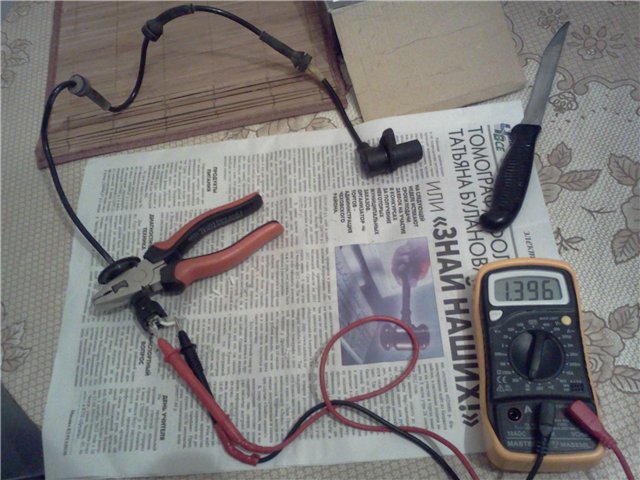
Automakers strive to make their products as safe as possible, for this purpose in sedans, hatchbacks, crossovers, etc. additional systems and components are installed. These modules also include ABS, which allows you to ensure the straightness of the vehicle during sudden braking on difficult road surfaces.
With frequent use, individual elements wear out, and diagnostic work has to be carried out to identify breakdowns. Let's figure out how to check the ABS sensor with a tester in various cars, because it is used to read electronic impulses transmitted to the ECU (electronic control unit).
The sensor operates in conjunction with a special toothed comb and is an induction coil. The information is analyzed in the ECU, and as a result, the pressure on the brake cylinders is adjusted through the hydraulic system.
The most common malfunctions that occur in these units are associated with an open circuit between the control unit and the sensor itself. also fail due to mechanical or electrical damage, in which case the pulse is incorrectly transmitted to the ECU.
Possible problems are indicated by a special light sensor on the dashboard. For more accurate diagnosis, it is necessary to use special devices.
The ABS sensor is checked by the tester independently after the indicator lights up. You will also need a vehicle operating manual and an assistant. The contacts with the necessary PIN connectors are first output.
The work is performed in the following sequence:
- the car is lifted using a jack or hung on a special lift;
- for ease of access to the sensor, the wheel is dismantled;
- on the back side of the hub, unscrew the fasteners that secure the required unit;
- we get rid of the casing on the ABS block and disconnect the connections to the controllers in it;
- We put a repair cable with PIN contacts on the tester, and connect the other end to the sensor socket;
- measure the resistance on the contacts and compare the readings with the factory parameters specified in the car’s operating instructions;
- test the wiring to make sure there is no short circuit to ground.
After this work, we turn the wheel by hand and measure the resistance. This operation requires someone's help. As the wheel speed changes, the data on the multimeter should also vary and respond to that speed.
The resistance of the ABS sensor is usually around 1 kOhm (1000 Ohm). It depends on the specific car model, since everyone has different sensors. So, for example, for one model the norm will be 600 Ohms, and for another 1350 Ohms.
Monitoring the performance of sensors can be done using the “voltmeter” mode on a multimeter. The operation is carried out on each of the sensors in turn. To do this, you need to perform the following algorithm:
- alternately jack up the required side with the wheel;
- PIN cable connectors connect to the tester;
- the wheel will need to be rotated at the most accurate frequency of 1 rpm.
The multimeter should show readings in the range of 0.25-1.20 V. As the rotation speed increases, there should be a noticeable tendency for the voltage reading on the tester screen to increase.
In addition to a multimeter, testing can be carried out using a more informative device for this purpose, for example, an oscilloscope. It forms a graph on the monitor, the amplitude of which determines the resistance level. However, this device is quite expensive for home use and requires qualified service by a specialist.
An oscilloscope can be found at specialized stations that professionally diagnose cars.
Many ABS systems in modern cars have a self-diagnosis function. By activating this function, the driver will receive a special error code on the on-board computer monitor, encrypted using numbers and letters. The operating instructions for this car model will help you understand the decoding.
You can replace a faulty sensor yourself. Before the procedure, you must order this item from an authorized dealer.
The updated sensor must be tested on a flat section of the road, braking at a speed of 20-40 km/h. To do this, the brake pedal must be sharply pressed to the floor.
When operating correctly, a slight vibration transmitted from the operating unit will be felt under the driver’s foot on the pedal. You should also hear the characteristic sound of the pads braking. If necessary, the wiring is also replaced.
As a result, there should be the same system testing results.
Source: http://ymp3.ru/avtoremont-i-tyuning/kak-proverit-datchik-abs-testerom
How to check abs sensors
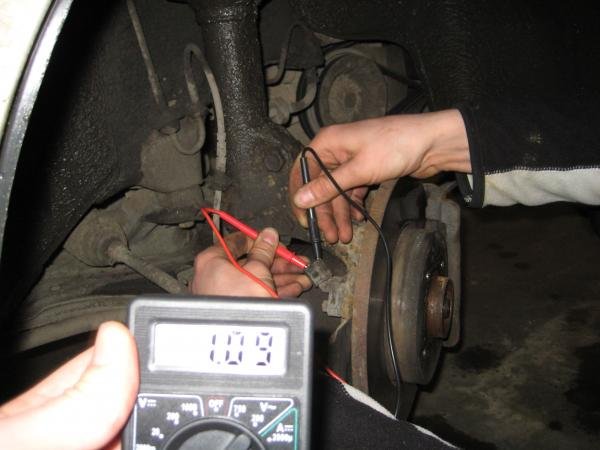
Turning on the power of any modern car, including budget Opel and luxury cars, is accompanied by the ABS (anti-lock braking system) light turning on on the front panel.
This indicates that the automatic test control of the electronic control unit has started, and if it is working correctly, the signal immediately goes out.
If the lamp continues to light, you should check the ABS sensor and find out what the problem is.
What is an ABS sensor?
Front-wheel drive cars are equipped with 4 sensors - one for each wheel. For rear-wheel drive and all-wheel drive models, such as the Nissan Cefiro, one is enough. Data about the possibility of blocking is taken from one wheel and transmitted to the other three. In this case, the entire ABS system consists of the following elements:
- ABS sensors that record wheel speed and convert it into an electrical signal;
- a control unit that receives signals from sensors and transmits influence to the hydraulic unit;
- hydraulic unit consisting of pressure accumulators, solenoid valves and a return pump.
If, during braking, the amount of deceleration of the wheel speed exceeds the normal value, the system concludes that there is a blockage and opens the exhaust valve. The brake fluid pressure drops. After the rotation speed has returned to normal, the valve closes.
Thanks to this, the change in pressure in the brake system is stepped, the likelihood of wheel locking and, accordingly, deterioration in vehicle controllability is reduced. And the braking distance is minimal. If problems arise with the ABS, it may be disabled.
This can be avoided by promptly responding to the signal from the front panel.
Methods of testing for functionality
There are several ways to check the ABS sensor. The first of them is visual, which consists of disassembling and inspecting the unit.
First of all, you should pay attention to the abrasions of the wiring and the integrity of all connectors, and secondly, to the degree of wear of individual elements. If burnt or worn parts of the system are detected, they are replaced with new ones.
And, if a visual examination does not yield anything, they move on to more accurate diagnostic methods.
Checking with a tester
To diagnose an ABS sensor, for example, on a Toyota car, using a multimeter (tester), you need:
- Raise the car using a jack (or place it on a lift);
- First remove the wheel and then the cover of the control unit;
- Disconnect the controller connectors;
- Connect the multimeter first to the special wires (PIN), and then to the contact connector of the sensor.
Now you can perform testing, which consists of measuring the resistance on the contacts. First, the electrical circuit is checked for a short circuit.
After this, the inspector should manually spin the wheel and read the readings of the device - first in ohmmeter mode, then using it as a voltmeter.
The values of all parameters must correspond to the information from the repair manual for this vehicle.
Using an Oscilloscope
Diagnostics are also performed using oscilloscopes that examine signal amplitude parameters. Sometimes they are replaced with special software on a laptop. To check the ABS sensor of a car like Ford, you should perform the following steps:
- Fully charge the car battery;
- Find the sensor and connect the oscilloscope to its contact connector;
- Rotating the wheel at a speed of about 3 revolutions per second, detect the amplitude of vibrations;
- Repeat the same with the second wheel of the same axle.
If the sensor is working properly, the vibration amplitude of both wheels will be the same. And when rotating at a speed of no more than 0.2 rps, it should generally be completely level. Detection of significant discrepancies in readings indicates a malfunction of the device.
Diagnostics without instruments
The easiest method to determine if the ABS sensor of your BMW or any other car model is bad is to check the valve on the inductive sensor. To do this, apply any metal product (screwdriver or key) to the part. If the sensor attracts metal objects, it is working properly. If not, it will most likely need to be repaired or replaced.
Video:
Source: http://autoprivat.ru/remont_avto/kak_proverit_abs_datchiki.html
How to check and repair the ABS sensor yourself?
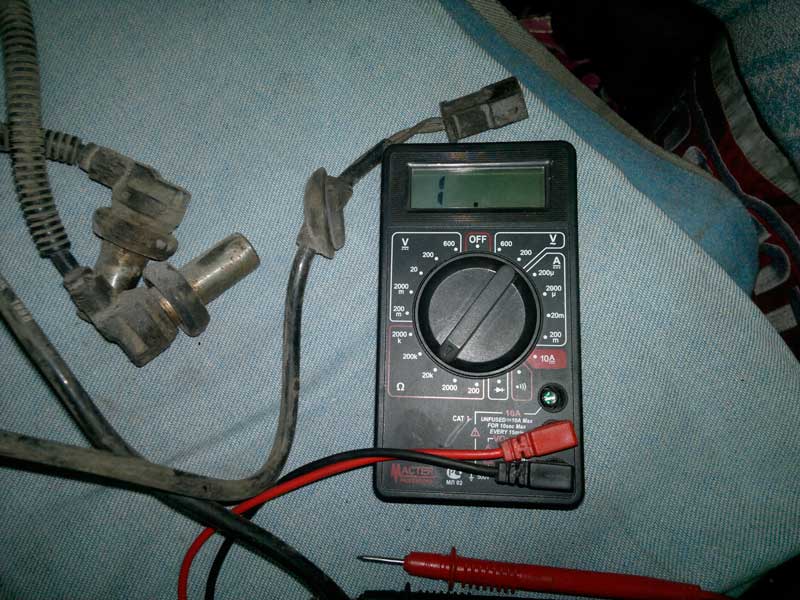
How to determine the functionality of the device with your own hands, how to check the resistance of the front right or left ABS sensor with a tester? To begin with, we suggest that you familiarize yourself with the basic information regarding this controller.
Purpose and functions
As stated above, the wheel speed sensor is an integral part of any ABS system.
The purpose of the anti-lock braking system is to prevent the car's wheels from locking when braking and maintaining vehicle stability.
The main purpose of the controller is to transmit data on wheel rotation to the control unit, according to which the control model calculates the degree of wheel slip.
Location
Where is the device located? The device itself, regardless of the car model and the anti-lock braking system, is located on the wheel hub.
Principle of operation
Now let's talk about how the device works. The brake cylinder transmits pressure, which is used to generate pressure in the calipers.
Because of this force, the brake pads are pressed against the discs as much as possible, and the level of pressure is always the same, regardless of how hard the driver presses the brake pedal. It is thanks to the controllers that the wheel rotation speed is monitored, after which this data is transmitted to the control module.
The latter, in turn, compares these indicators and transmits the corresponding signals to the valves of the hydraulic module, which regulates the pressure.
When emergency braking occurs, these valves operate at a higher frequency, and an uncharacteristic chattering noise is heard, which indicates that the wheels are locked.
In this case, the pressure level in one or more circuits instantly increases and decreases.
Ultimately, the pads compress and release the brake discs, which contributes to intermittent braking (video author: Denis Shchukin).
Methods for checking the regulator
Now let's move on to the issue of checking the device with your own hands. Before removing and checking the controller, it is necessary to diagnose the condition of the electrical circuit - damage to the wiring is considered one of the most common problems.
So you need to know how to ring the device and check the resistance with a multimeter. The diagnostic device must be connected to the controller contacts, and then simply check the resistance value.
This value must be within the established limits, which must be indicated in the service manual for the car.
If the diagnostics showed that the resistance does not correspond to the normalized value or this value tends to zero, then most likely there is a short circuit in the electrical circuit.
If the controller itself operates normally without interruptions, then the multimeter should produce the following values:
- The resistance on the front controller should vary between 7-25 Ohms;
- on the rear device this value should be approximately 6-24 Ohms;
- The insulation resistance value must be at least 20 kOhm.
Most modern cars are equipped with self-diagnosis systems. In this case, the test can be launched on the control panel, where certain combinations of errors will be displayed.
To determine the breakdown, all codes must be deciphered.
Combinations of faults vary depending on the car, so when performing this procedure you should have the service book for the car at hand.
Photo gallery “Do-it-yourself sensor diagnostics”
Possible malfunctions and ways to eliminate them
What problems can occur in the operation of controllers:
- The Check Engine indicator on the dashboard comes on, and the ABS warning light may also come on. In most cases, the cause of this problem is related to malfunctions in the control module or damage to the electrical wiring. If the electrical circuit is damaged, the control module will not be able to receive signals from the controllers. In any case, damaged wires must be replaced; if the problem lies in the control unit, then it must be repaired.
- It is possible that the ABS system successfully performs self-diagnosis and then randomly turns off. With such a problem, the malfunction may lie in damaged wiring, oxidation of the controller contacts, or poor connection of the device to the circuit. Also, the reason may lie in the sensor shorting to ground. It is necessary to check the wiring itself, the quality of the connection (turn off and turn on the sensor again, while cleaning the contacts), and also clean the ground.
- The sensor has failed. This device cannot be repaired, so when it breaks, it must be replaced. There is nothing complicated about this, you just need to remove the wheel itself, disconnect the connector and dismantle the controller, and then install a new device in its place.
- Damage to the winding on the sensor itself. Some car owners practice repairing devices with such a problem by rewinding the wire. As practice shows, such repairs are sometimes advisable, in particular if the device has not yet reached the end of its service life.
Loading …
Video “Removing and repairing the ABS sensor”
Find out how to dismantle and then rewind the wire on the anti-lock braking system sensor with your own hands from the video below (author - Renault Megane BortJournal channel).
Source: https://avtoklema.com/sensors/datchik-abs-3268/
Has the ABS light come on? Reasons for checking the sensor
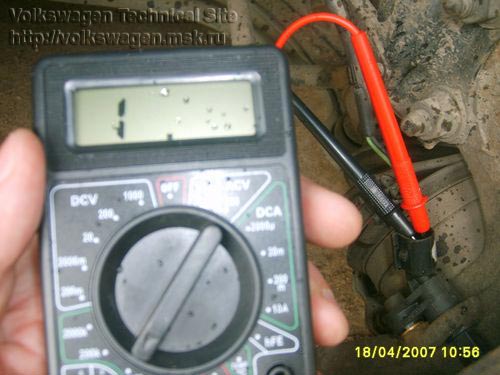
Immediately after turning on the power, the “ABS” indicator light should light up on the car’s dashboard, indicating that the car’s electronic unit is ready for operation. If everything is in order with the car, then after a couple of minutes the inscription disappears. But the ABS unit may well fail: how to check the ABS sensor and understand what exactly is broken?
Content:
How does ABS work?
The development of the system, which began to be actively installed on manufactured cars in the 1970s, brought the concept of safety to a new level.
It consists of:
- control unit;
- hydraulic drive;
- controllers that control wheel speed;
- mechanism for braking.
The control unit is considered the most important: it evaluates the signals coming from the sensors. The data is analyzed online, and the system understands what is happening with the car: it is slowing down or starting to go faster. Next, the processed data is transmitted to the hydraulic unit.
The brake cylinder is responsible for transmitting the pressure necessary to create the pressing force that ensures that the pads are pressed against the discs. Regardless of how hard the driver presses the brake, the pressure level in the system will be the most optimal.
The main advantage of ABS is the ability of the system to analyze the condition of each wheel individually, selecting the most appropriate pressure and preventing blocking.
Braking to a complete stop is ensured by the pressure generated in the brake drive.
On all-wheel drive and rear-wheel drive cars, a single sensor is installed, located on the rear axle: data to the main unit responsible for control comes from the nearest wheel, and a signal setting the required pressure level is sent to all wheels at once.
There are three possible operating modes for the valve control device:
- if the inlet valve is open and the exhaust valve is closed, the pressure will increase, since there are no obstacles to this;
- the inlet valve can remain closed after receiving a corresponding signal, which ensures that the pressure level remains unchanged;
- The exhaust valve opens and the inlet valve closes, which helps reduce pressure.
The presence of these operating modes ensures that the increase or decrease in pressure will occur smoothly. When any problems arise in the operation of the ABS system, the brake mechanism begins to function without its participation, and a corresponding notification lights up on the panel.
How to check the serviceability of the ABS sensor yourself
When the sensor begins to function incorrectly, the anti-lock braking system stops receiving signals and responding to them properly, which can lead to wheel locking.
The sensor is an inductance coil that operates simultaneously with a toothed disk located on the hub.
ABS diagnostics show that one of the most common causes of malfunction is a cable break. A soldering iron, a special cord intended for repairs, and a tester will help determine the nature of the malfunction.
The cable contacts are connected to the connectors, then the tester sets the resistance of the unit (the resulting value must be within the permissible limits specified in the device’s operating manual). A resistance close to zero indicates a short circuit, but if the resistance goes far beyond the maximum values, there is a break.
Checking the wheel is the next step: changing resistance means that the sensor is working and does not need to be replaced. Detected breaks must be eliminated: any break is corrected by soldering, but in no case by twisting, which reduces the likelihood of new breaks and the start of the oxidation process to a minimum.
If diagnostics of the ABS sensor show that it is faulty and cannot be repaired, it must be disconnected and replaced with a new one.
How to properly check the ABS sensor for performance in order to prevent failures in its operation in the near future? To do this, you need to inspect the contacts of the device and make sure that the wiring is in good condition: the second most popular reason for the malfunction of the unit is a violation of its integrity.
If the ABS light comes on, a special diagnostic system will help simplify diagnostics of the unit and save money on a trip to a car service center, allowing even a non-specialist to carry out the check: after it starts, error codes will appear on the screen. You can find out what they mean using the instructions supplied with the device.
Main types of ABS malfunctions
Sometimes when you press the brakes, a rattling sound occurs, making drivers think that there is something wrong with their vehicle. But this sound is not a sign of a breakdown: cracking can occur while the modulators are operating.
If the ABS fails, then after starting the engine the icon on the panel does not go out, continuing to light all the time.
During the diagnostic process, the following malfunctions may be detected:
- An error found during testing is removed by the ABS system itself. This does not mean that the malfunction has been eliminated: simply, either an error occurs in the main controller unit, or there is a break in the sensor wiring.
- When the ABS starts, self-diagnosis takes place in normal mode, but then the device turns off spontaneously. Possible causes include poor-quality contacts or their oxidation, a break in the cable responsible for power supply, or a short circuit in the sensor.
- After the ABS starts, the self-diagnosis system finds an error, but still works. In most cases, this indicates a break in the sensor, as a result of which information about the wheel speed begins to be transmitted from another device. The cause of the malfunction may also be a difference in tire pressure: if one tire is flat, it will work slower. A similar situation occurs when installing tires with different treads.
- ABS doesn't work at all. The most likely causes will be a break, a heavily worn wheel bearing, or rotor play. To troubleshoot the problem, you should first check the play and condition of the rotor. If chips are found, the element should be replaced. Next - check the wires suitable for the device. If this measure does not lead to the desired result, then the whole problem is in the electronics - in this case, you need to use the diagnostic system to find out the error code to eliminate it.
Video: how to check the ABS sensor with a tester
Source: http://moj-vnedorozhnik.ru/v-pomoshch-voditelyu/kak-proverit-datchik-abs


